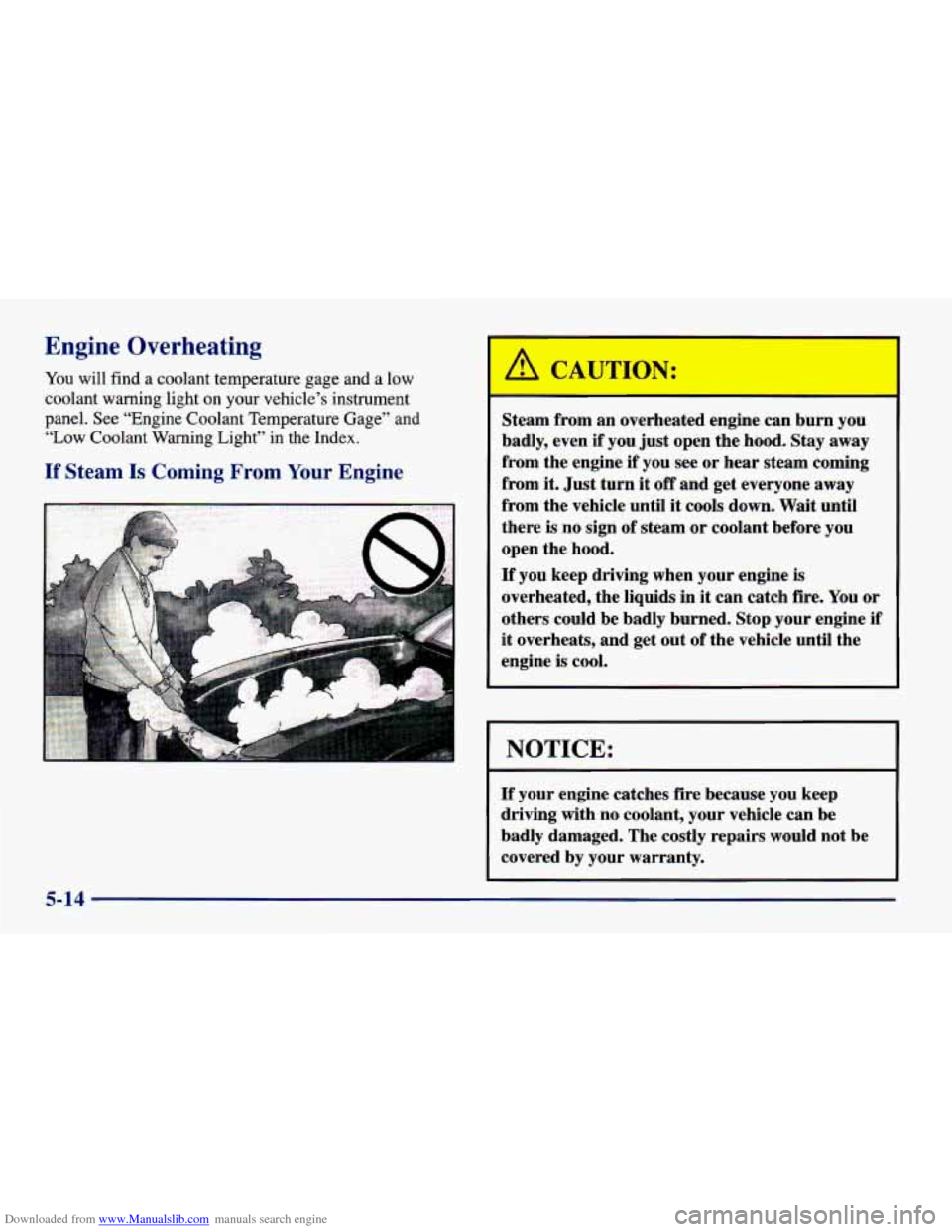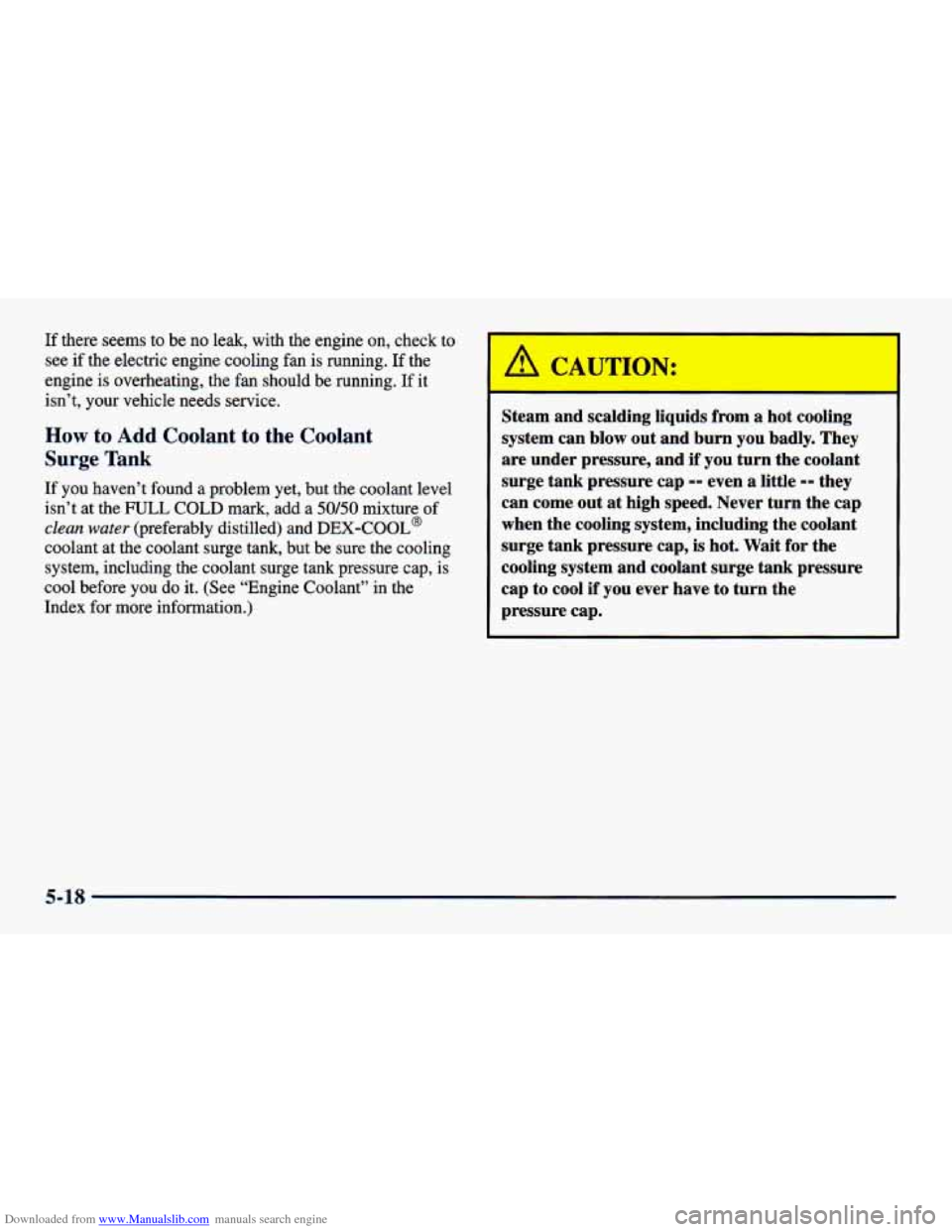Page 236 of 400

Downloaded from www.Manualslib.com manuals search engine Engine Overheating
You will find a coolant temperature gage and a low
coolant warning light on your vehicle’s instrument
panel. See “Engine Coolant Temperature Gage” and
“Low Coolant Warning Light’’ in the Index.
If Steam Is Coming From Your Engine
Steam from an overheated engine can burn you
badly, even if you just open the hood. Stay
away
from the engine if you see or hear steam coming
from it. Just turn it
off and get everyone away
from the vehicle until it cools down. Wait until
there is no sign
of steam or coolant before you
open the hood,
If you keep driving when your engine is
overheated, the liquids in
it can catch fire. You or
others could be badly burned. Stop your engine
if
it overheats, and get out of the vehicle until the
engine is cool.
NOTICE:
If your engine catches fire because you keep
driving with
no coolant, your vehicle can be
badly damaged, The costly repairs would not be
covered by your warranty.
5-14
Page 238 of 400
Downloaded from www.Manualslib.com manuals search engine Cooling System
When you decide it’s safe to lift the hood, here’s what
you’ll see:
2.2L Engine
A. Coolant Surge Tank with Pressure Cap
B. Electric Engine Cooling Fan
2.4L Engine
A. Coolant Surge Tank with Pressure Cap
B. Electric Engine Cooling Fan
5-16
Page 239 of 400
Downloaded from www.Manualslib.com manuals search engine An electric engine cooling fan under the hood can
start up even when the engine is not running and
can injure you. Keep hands, clothing and tools
away from any underhood electric fan.
If the coolant inside the coolant surge tank is boiling,
don’t
do anything else until it cools down.
If it isn’t, you may have a leak in the radiator hoses,
heater hoses, radiator, water pump
or somewhere else in
the cooling system.
I
L,,,,s and radiator hoses, and othei -ngL
parts, can be very hot. Don’t touch them.
If you
do, you can be burned.
Don’t run the engine if there
is a leak. If you run
the engine,
it could lose all coolant. That could
cause an engine fire, and you could be burned.
Get any leak fixed before you drive the vehicle.
NOTICE:
Engine damage from running your engine
without coolant isn’t covered by your warranty.
The coolant level should be at the FULL COLD line.
5-17
Page 240 of 400

Downloaded from www.Manualslib.com manuals search engine If there seems to be no leak, with the engine on, check to
see
if the electric engine cooling fan is running. If the
engine is overheating, the fan should be running. If
it
isn’t, your vehicle needs service.
How to Add Coolant to the Coolant
Surge Tank
If you haven’t found a problem yet, but the coolant level
isn’t at the
FULL COLD mark, add a 50/50 mixture of
clean water (preferably distilled) and DEX-COOL@
coolant at the coolant surge tank, but be sure the cooling system, including the coolant surge tank pressure cap, is
cool before you do it. (See “Engine Coolant” in the
Index for more information.)
Steam and scalding liquids from a hot cooling
system can blow out and burn you badly. They
are under pressure, and
if you turn the coolant
surge tank pressure cap
-- even a little -- they
can
come out at high speed. Never turn the cap
when the cooling system, including the coolant
surge tank pressure cap,
is hot. Wait for the
cooling system and coolant surge tank pressure
cap to cool
if you ever have to turn the
pressure cap.
5-18
Page 241 of 400
Downloaded from www.Manualslib.com manuals search engine 1
Adding only plain wirccr to your cooling system
can be dangerous. Plain water, or some other
liquid like alcohol, can boil before the proper
coolant mixture will. Your vehicle's coolant
warning system
is set for the proper coolant
mixture. With plain water or the wrong mixture,
your engine could get too hot but you wouldn't
get the overheat warning. Your engine could
catch fire and you or others could be burned.
Use
a 50/50 mixture of clean water and
DEX-COOL@ coolant.
5-19
Page 242 of 400
Downloaded from www.Manualslib.com manuals search engine NOTICE:
In cold weather, water can freeze and crack the
engine, radiator, heater
core and other parts. So
use the recommended coolan-.
r--
-
You can be burned if you spill coolant on hot
engine parts. Coolant contains ethylene glycol
and
it will burn if the engine parts are hot
enough. Don't spill coolant on a hot engine. 1. You can remove the coolant surge tank pressure cap
when the cooling system, including the coolant surge
tank pressure cap and upper radiator hose, is
no
longer hot. Turn the pressure cap slowly about
one-quarter turn to the left and then stop.
If you hear a hiss, wait for that to stop. A hiss means
there
is still some pressure left.
5-20
Page 243 of 400
Downloaded from www.Manualslib.com manuals search engine 2. Then keep turning the
pressure cap slowly,
and remove it.
3. Then fill the coolant surge tank with the proper
mixture, up to the FULL COLD mark.
5-21
Page 244 of 400
Downloaded from www.Manualslib.com manuals search engine 4. With the coolant surge tank pressure cap off, start the
engine and let it run until you can feel the upper
radiator hose getting hot. Watch
out for the engine
cooling fan.
By this time, the coolant level inside the coolant
surge tank may be lower.
If the level is lower, add
more
of the proper mixture to the coolant surge tank
until
the level reaches the FULL COLD mark.
5. Then replace the
pressure cap. Be sure
the pressure cap is tight.
Check the level in the surge tank when the cooling system has cooled down.
If the coolant isn't at the
proper level, repeat Steps
1 to 3 and reinstall the
pressure cap or
see your dealer.
5-22